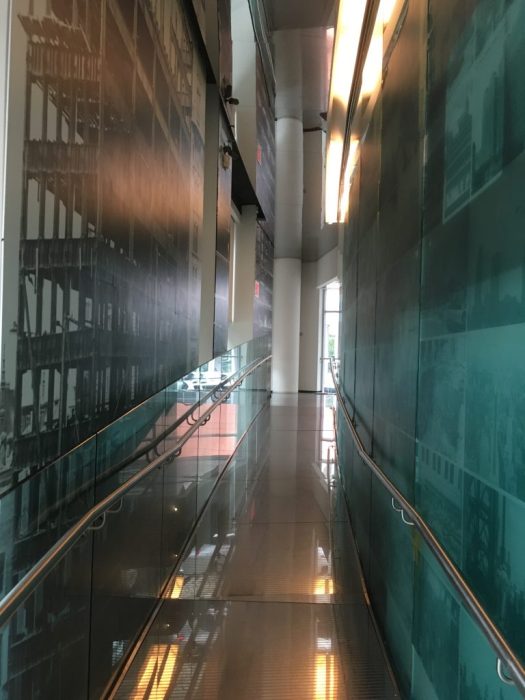| Edification value | |
|---|---|
| Entertainment value | |
| Should you go? | |
| Time spent | 60 minutes |
| Best thing I saw or learned |  Seeing an original architectural scale model of the World Trade Center drives home just how huge and boxy those buildings were. I think it’s because today’s supertall skyscrapers are so super skinny, but also I guess I’m slowly forgetting what they looked like on the skyline. Seeing an original architectural scale model of the World Trade Center drives home just how huge and boxy those buildings were. I think it’s because today’s supertall skyscrapers are so super skinny, but also I guess I’m slowly forgetting what they looked like on the skyline. |
The United States has contributed two distinctively native art forms to the world: jazz and skyscrapers. Both have become global, and both arguably reached their peak in the mid-twentieth century and have gently declined ever since. And both have museums in New York.
 The small, scrappy Skyscraper Museum is located in ground floor space in the Ritz Carlton Hotel in Lower Manhattan. Its host building is only 38 stories tall, so not especially impressive by New York skyscraper standards. However, it does have a prominent location when viewing Manhattan from the harbor.
The small, scrappy Skyscraper Museum is located in ground floor space in the Ritz Carlton Hotel in Lower Manhattan. Its host building is only 38 stories tall, so not especially impressive by New York skyscraper standards. However, it does have a prominent location when viewing Manhattan from the harbor.
It’s an oddly, if cleverly, designed space. You enter via a ramp that leads gently upward through a narrow hallway, emphasizing verticality.
Then the main room features mirrored ceilings and shiny metal floors. The combination maximizes natural light, and also creates the illusion of greater height than really exists, clever given the subject matter.

However, the museum needs more space than it has, resulting in some narrow squeezes between displays that don’t always serve the exhibits all that well. Lack of space — and attendant high land prices — helped inspire the development of the skyscraper in the first place, so maybe it’s fitting that the same problem afflicts the Skyscraper Museum.

Proto Skyscrapers in Old New York
Like a summer superhero movie, the Skyscraper Museum’s current special exhibition tells an origin story. Called “Ten & Taller: 1874-1900,” the exhibit examines building technologies, uses, and contemporary reaction as the city just started reaching for the sky. The museum has compiled a database of 253 buildings 10 stories or taller built before 1900, including offices, hotels, and apartments. It’s interesting to imagine New York as a low high-rise city, when a 30-story building at 15 Park Row was the tallest office building in the world.
The Proto-Skyscraper Era lasted only briefly, as architects and engineers mastered the steel frame and deployed it to climb to ever higher heights in the twentieth century. However, somewhat to my surprise, a bit more than half of the buildings covered in the exhibit still stand today. I expected most of them to have been long since been replaced by something taller and more lucrative.
Although New York does indeed continually demolish and reinvent itself, more of the past remains than we sometimes realize.

Other Things to See
In addition to its temporary exhibition, the Skyscraper Museum features some permanent displays:
- Architectural and wind tunnel models of a few key supertall buildings from around the world
- A timeline charting the literal and figurative rise of tall buildings globally
- Exhibits on design and construction techniques
- A rundown on the different ways organizations measure building height for official, “world’s tallest” purposes
More poignantly, it devotes a section to the architecture of the World Trade Center. This includes two original models for the twin towers, a documentary about their construction, and some pieces related to the rebuilding. It also includes contemporary criticism of the WTC by Ada Louise Huxtable (then the Times’s architecture critic) and others.

Who Should Visit?
I love the idea of the Skyscraper Museum. It’s still a young institution, and it’s still finding ways to tell the stories it wants to tell. Buildings, like jazz, aren’t necessarily easy to capture in museum-friendly formats (also see the Center for Architecture). It deploys a lot of wall-text-and-images installations, some of which are at least as good, if not better, on the museum’s website.
My other main criticism is that the Skyscraper Museum very much needs more space to fulfill its potential. It’s already more densely packed than is really good for showing off the collection.
While it needs improvement, it’s still a unique and valuable addition to New York’s museum universe. If you’re an architecture buff, you should go for sure. If you’re interested in the World Trade Center, it’s a great place to learn how they constructed the original. And if you, like me, still feel your heart beat a little faster whenever you see Manhattan’s skyline from a distance, the Skyscraper Museum will help you understand the economic and engineering forces that shape this deeply American, but now global, art.
For Reference:
| Address | 39 Battery Place, Manhattan |
|---|---|
| Website | skyscraper.org |
| Cost | General Admission: $5 |
| Other Relevant Links |
|
